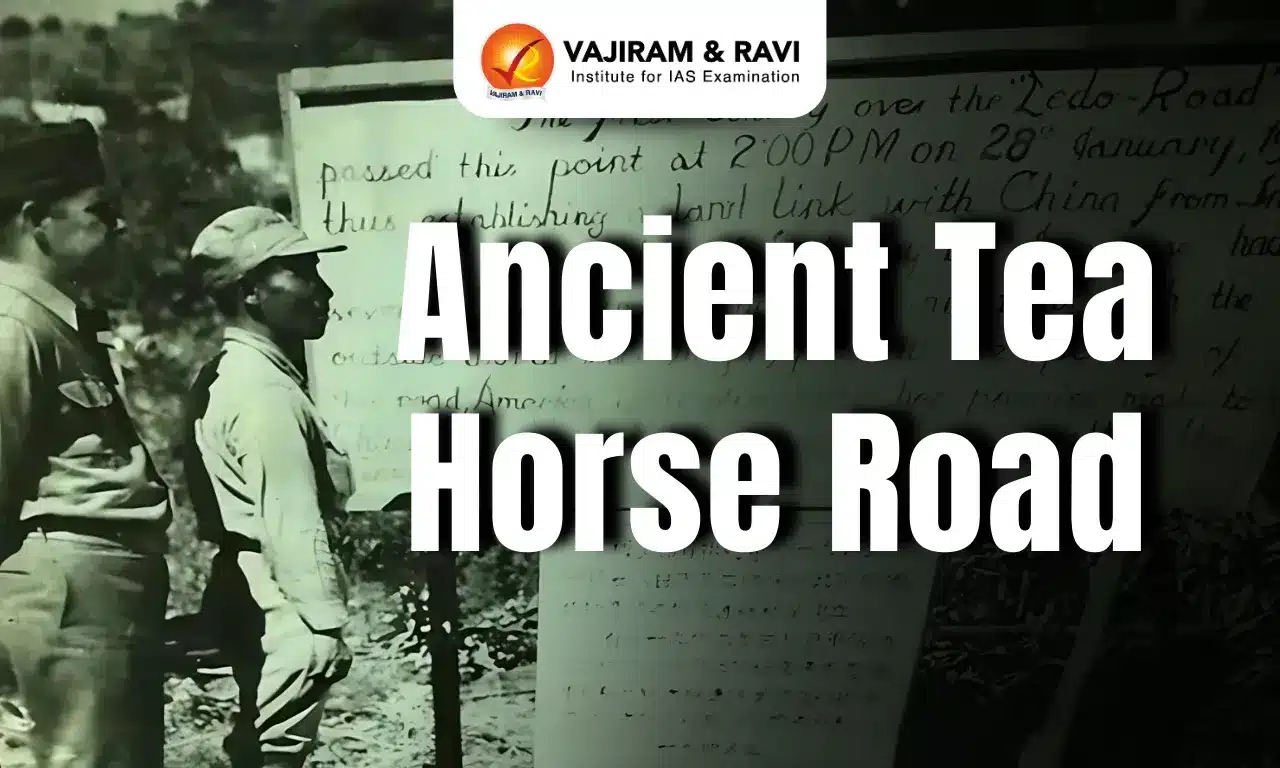What’s in Today’s Article?
- India-China Bilateral Relationship Latest News
- Introduction
- Origins of the Tea Horse Road
- A Network of Roads Across Difficult Terrain
- Tea and Horses – The Core of the Trade
- The Road’s Role in Modern History
- Revival of the Tea Horse Road as a Cultural Landmark
- Conclusion
- Tea Horse Road FAQs
India-China Bilateral Relationship Latest News
- China’s Ambassador to India Xu Feihong posted on X (Twitter) about the historic Tea Horse Road which spanned more than 2,000 km, and connected China to India via Tibet.
Introduction
- The Tea Horse Road, an ancient trade network connecting China, Tibet, and India, played a key role in commerce and cultural exchange for centuries.
- While less famous than the Silk Road, this route facilitated the movement of tea, horses, and other valuable commodities across some of the world’s most challenging terrains.
- On February 25, 2025, China’s Ambassador to India, Xu Feihong, highlighted the historical significance of the Tea Horse Road, emphasizing its role in strengthening India-China ties through history.
Origins of the Tea Horse Road

- The Tea Horse Road traces its origins to the Tang Dynasty (618-907 CE), when trade between Southwest China, Tibet, and India first flourished.
- Buddhist monk Yijing (635-713 CE) documented early trade exchanges, mentioning the movement of goods such as sugar, textiles, and rice noodles from China, while horses, Tibetan gold, saffron, and medicinal herbs were exported.
- By the 10th century, during the Song Dynasty (960-1279 CE), official markets were established along the route to regulate the trade of tea and horses, which became the dominant commodities exchanged between China and Tibet.
A Network of Roads Across Difficult Terrain
- The Tea Horse Road was not a single pathway, but a network of trails originating in Southwest China and reaching deep into the Indian subcontinent, Nepal, and Bangladesh.
- Key Features of the Route:
- Length: Over 2,000 km
- Key Cities: Passed through Dali, Lijiang (Yunnan Province), and Lhasa (Tibet)
- Elevation: Reached up to 10,000 feet in the Himalayas
- Challenges: Harsh terrain, extreme weather, and high altitudes made the journey perilous for traders
- Despite these difficulties, traders travelled extensively, carrying tea from Sichuan to Tibet and India, while returning with horses and other essential goods.
Tea and Horses – The Core of the Trade
- Tea was a necessity for Tibetan nomads, who lived in cold and harsh climates. According to National Geographic, yak butter tea became a staple for Tibetans, providing essential warmth and energy.
- Meanwhile, horses were crucial for China’s military. Since the central plains of China lacked horses, they had to be imported from Tibet and Yunnan.
- Tibetan steeds became highly valued, particularly in China’s conflicts against Mongolian tribes.·
- To regulate this exchange, China’s Song Dynasty government established official markets, ensuring a controlled trade of tea and horses, which contributed to regional economic stability.
The Road’s Role in Modern History
- Expansion of Trade in the Early 20th Century
- With the fall of the Qing Dynasty in 1912, the Tea Horse Road became even more vital. Yunnan’s tea industry expanded as China integrated into the global market.
- New trade techniques and goods were introduced to the mountainous regions, increasing economic opportunities.
- World War II and the Road’s Strategic Importance
- During World War II, when Japan controlled much of China’s coastline, the Tea Horse Road served as an alternative supply route for transporting goods and military supplies to China’s resistance forces.
- Decline After the Founding of the People’s Republic of China (1949)
- Following the establishment of the People’s Republic of China, the importance of the Tea Horse Road declined.
- Mao Zedong’s land reforms significantly changed trade patterns, and with the advancement of modern transportation, the historic trade route lost its relevance.
- However, some remnants remain, particularly in regions like Lijiang, which became a UNESCO World Heritage Site in 1997 due to its historical significance in trade.
Revival of the Tea Horse Road as a Cultural Landmark
- In recent years, China has promoted tourism along the ancient trade route, highlighting its historical importance.
- The city of Lijiang, once a crucial trade hub, has been transformed into a cultural and heritage site, drawing visitors from across the world.
- According to UNESCO, Lijiang was an important distribution center for trade between Sichuan, Yunnan, and Tibet, where it intersected with southern Silk Road routes. Today, the city serves as a testament to the Tea Horse Road’s enduring legacy.
Conclusion
- The Tea Horse Road was more than just a trade route; it was a lifeline connecting China, Tibet, and India for centuries.
- While its significance has diminished in modern times, it remains a historical and cultural symbol of international exchange.
- Today, efforts to preserve its legacy through tourism and research highlight its role in shaping the economic and cultural landscapes of the regions it once traversed.
- The renewed focus on this historic route serves as a reminder of the deep historical ties between India and China.
Tea Horse Road FAQs
Q1. What was the Tea Horse Road?
Ans. The Tea Horse Road was an ancient trade network connecting China, Tibet, and India, facilitating the exchange of tea, horses, and other goods.
Q2. When did the Tea Horse Road originate?
Ans. The route dates back to the Tang Dynasty (618-907 CE) and played a crucial role in trade until the mid-20th century.
Q3. Why was tea important in Tibet?
Ans. Tibetan nomads relied on tea as a source of warmth and energy, often consuming yak butter tea in cold climates.
Q4. How did the Tea Horse Road impact military trade?
Ans. China imported horses from Tibet to strengthen its military, while Tibet received tea and other essential supplies in return.
Q5. Is the Tea Horse Road still in use today?
Ans. While no longer a commercial trade route, parts of the Tea Horse Road are being preserved as cultural heritage sites, particularly in Lijiang, China.
Source: IE
Last updated on June, 2025
→ UPSC Notification 2025 was released on 22nd January 2025.
→ UPSC Prelims Result 2025 is out now for the CSE held on 25 May 2025.
→ UPSC Prelims Question Paper 2025 and Unofficial Prelims Answer Key 2025 are available now.
→ UPSC Calendar 2026 is released on 15th May, 2025.
→ The UPSC Vacancy 2025 were released 1129, out of which 979 were for UPSC CSE and remaining 150 are for UPSC IFoS.
→ UPSC Mains 2025 will be conducted on 22nd August 2025.
→ UPSC Prelims 2026 will be conducted on 24th May, 2026 & UPSC Mains 2026 will be conducted on 21st August 2026.
→ The UPSC Selection Process is of 3 stages-Prelims, Mains and Interview.
→ UPSC Result 2024 is released with latest UPSC Marksheet 2024. Check Now!
→ UPSC Toppers List 2024 is released now. Shakti Dubey is UPSC AIR 1 2024 Topper.
→ Also check Best IAS Coaching in Delhi
























